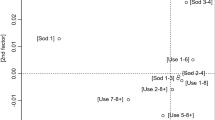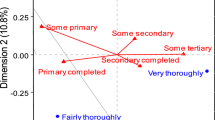Summary
Correspondence analysis is a popular graphical tool used to analyse contingency tables. In the past, it has commonly been performed by applying a singular value decomposition to a transformation of the data in the contingency table. A recent advance in its theory is to perform a bivariate moment decomposition instead. This approach is especially useful for the detection of linear and non-linear associations between ordinal variables; a feature not readily available using singular value decomposition.
This paper outlines S-PLUS code that will perform correspondence analysis using bivariate moment decomposition. It also includes a simple plotting function that will enable the graphical interpretation of the different levels of association.

Similar content being viewed by others
References
Beh, E. J. (1997). Simple correspondence analysis of ordinal crossclassifications using orthogonal polynomials.Biometrical Journal, 39, 589–613.
Beh, E. J. (1998). A comparative study of scores for correspondence analysis with ordered categories.Biometrical Journal, 40, 413–429.
Beh, E. J. (2003a). Simple correspondence analysis : A bibliographic review.International Statistical Review, (in review).
Beh, E. J. (2003b). Singly ordered simple correspondence analysis.The Australian and New Zealand Journal of Statistics, (in review).
Benzecri, J.-P., & Benzecri, F. (1989). Programmes for correspondence analysis and hierarchical clustering: User’s guide (French).Cahiers de l’Analyse des Donnees, 14, 7–34.
Best, D. J. (1994). Nonparametric comparison of two histograms.Biometrics, 50, 538–541.
Best, D. J., & Rayner, J. C. W. (1996). Nonparametric analysis for doubly ordered two-way contingency tables.Biometrics, 52, 1153–1156.
Blasius, J. H., & Rohlinger, H. H. (1988). KORRES: A program to analyze categorical data.Psychometrika, 53, 425–426.
Bond, J., & Michailidis, G. (1997). Interactive correspondence analysis in a dynamic objectoriented environment.Journal of Statistical Software,2.
Carr, J. R. (1990). CORSPOND: A portable FORTRAN-77 program for correspondence analysis.Computers and Geosciences, 16, 289–307.
Chen, J. S. (2001). A case study of Korean outbound traveler’s destination images by using correspondence analysis.Tourism Management, 22, 345–350.
Clement, B., & Levesque, D. (1984). A SAS program for correspondence analysis using PROC MATRIX.Proceedings of the SAS Users Group International Conference, 9, 645–650.
Crawley, M. J. (2002).Statistical Computing: An Introduction to Data Analysis using S-Plus. New York: Wiley.
Davy, P. J., Rayner, J. C. W., & Beh, E. J. (2003). Generalised correlation.The Mathematical Scientist, (in review).
Emerson, P. L. (1968). Numerical construction of orthogonal polynomials from a general recurrence formula.Biometrics, 24, 696–701.
Everitt, B. S. (1994).A Handbook of Statistical Analysis using S-PLUS. Chapman and Hall.
Everitt, B. S. (1997). Annotation: correspondence analysis.Journal of Child Psychology and Psychiatry, 38, 737–745.
Goodman, L. A. (1986). Some useful extensions of the usual correspondence analysis approach and the usual log-linear models approach in the analysis of contingency tables.International Statistical Review, 54, 243–309.
Gorman, B. S., & Primavera, L. H. (1993). MCA — a simple program for multiple correspondence analysis.Educational Psychological Measurement, 53, 685–687.
Greenacre, M. J. (1984).Theory and Application of Correspondence Analysis. London: Academic Press.
Greenacre, M. J. (1986). SIMCA: A program to perform simple correspondence analysis.The American Statistician, 40, 230–231.
Greenacre, M..J. (1987). Correspondence analysis on a personal computer.Chemometrics and Intelligent Laboratory Systems, 2, 233–234.
Grunsky, E. C. (2001). A program for computing RQ-mode principal component analysis for SPLUS and R.Computers & Geosciences, 27, 229–235.
Hegde, L., & Naik, D. (1999). Canonical correspondence analysis in SAS software.Proceedings of the Twenty-Fourth Annual SAS Users Group International Conference, 1607–1613.
Hoffman, D. L. (1991). Review of four correspondence analysis programs for the IBM PC.The American Statistician, 45, 305–311.
Krause, A., & Olson, M. (1997).The Basics of S and S-PLUS (2nd ed.). New York: Springer.
Lebart, L. (1982). Exploratory analysis of large matrices with applications to textual data. In P.E. H. Caussinus & R. Tomassone (Eds.),COMSTAT 1982 (p. 67–75).
Lebart, L., Morineau, A., & Warwick, K. (1984).Multivariate Descriptive Statistical Analysis. New York: Wiley.
Leighton, H. V., & Srivastava, J. (1999). First 20 precision among World Wide Web search services (search engines).Journal of the American Society for Information Science, 50, 870–881.
McEwan, J. A., & Schlich, P. (1992). Correspondence analysis in sensory evaluation.Food Quality and Preference, 3, 23–36.
Minno, J. (1990). Microcomputer tools to assist with perceptual mapping.Marketing News, 24 (23), 28–30.
Nishisato, S., & Arri, P. S. (1975). Non-linear programming approach to optimal scaling of partially ordered categories.Psychometrika, 40, 525–547.
Rayner, J. C. W., & Best, D. J. (1996). Smooth extensions of Pearsons product moment correlation and Spearmans Rho.Statistics and Probability Letter, 30, 171–177.
Rickards, O., Martinez-Labarga, C., Scano, G., De Stefano, G. F., Biondi, G., & Pacaci, M. (1998). Genetic history of the population of Sicily.Human Biology, 70, 699–714.
Romney, A. K., Moor’e, C. C., & Rusch, C. D. (1997). Cultural universals Measuring the semantic structure of emotion terms in English and Japanese.Proceedings of the National Academy of Science, USA, 94, 5489–5494.
Rosenzveig, C. (1978). Correspondence analysis on a microcomputer (French).Cahiers de l’Analyse des Donnees, 3, 418–434.
S-PLUS 6 : Programmer’s Guide for Windows. Seattle, WA, USA: Insightful Corporation.
Shi, M., & Carr, J. R. (2001). A modified code for R-mode correspondence analysis of large-scale problems.Computers & Geosciences, 27, 139–146.
Srole, L., Langner, T., Michael, S., Opler, M., & Rennie, T. (1962).Mental Health in the Metropolis: The Midtown Manhattan Study. New York: McGraw-Hill.
Thioulouse, J., Chessel, D., Doledec, S., & Olivier, J.-M. (1997). ADE-4: A multivariate analysis and graphical display software.Statistics and Computing, 7, 75–83.
Thompson, P. A. (1995). Correspondence analysis in statistical package programs.The American Statistician, 49, 310–316.
Tian, D. Q., Sorooshian, S., & Myers, D. E. (1993). Correspondence analysis with Mathlab.Computers and Geosciences, 19, 1007–1022.
Venables, W. N., & Ripley, B. D. (1994).Modern Applied Statistics with S-PLUS (3rd ed.). New York: Springer.
Watts, D. D. (1997). Correspondence analysis: A graphical technique for examining categorical data.Nursing Research, 46, 235–239.
Weller, S. C., & Romney, A. K. (1990).Metric Scaling: Correspondence Analysis. Newbury Park, CA : Sage: Sage University Paper Series of Quantification Applications in Social Sciences, 07–075.
Author information
Authors and Affiliations
Rights and permissions
About this article
Cite this article
Beh, E.J. S-PLUS code for ordinal correspondence analysis. Computational Statistics 19, 593–612 (2004). https://doi.org/10.1007/BF02753914
Published:
Issue Date:
DOI: https://doi.org/10.1007/BF02753914




